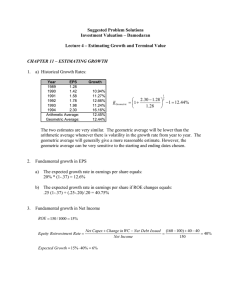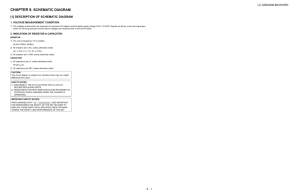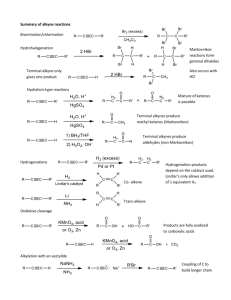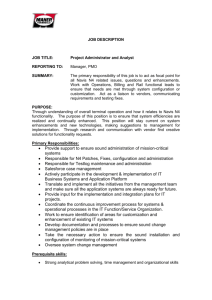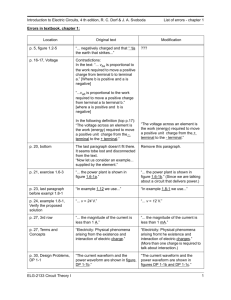Terminal Value
advertisement
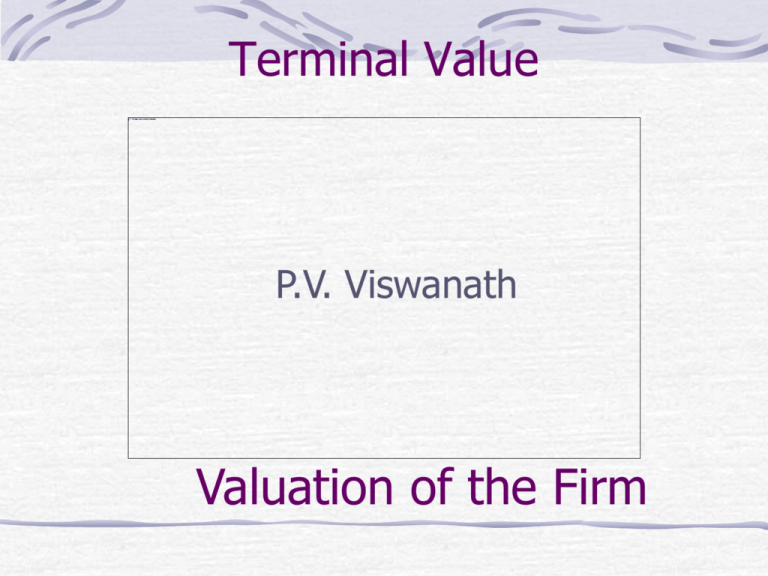
Terminal Value P.V. Viswanath Valuation of the Firm Getting Closure in Valuation A publicly traded firm potentially has an infinite life. The value is therefore the present value of cash flows forever. t = CF Value = t t t = 1 (1+ r) Since we cannot estimate cash flows forever, we estimate cash flows for a “growth period” and then estimate a terminal value, to capture the value at the end of the period: Value = t = N CFt Terminal Value t (1 + r)N t = 1 (1 + r) Estimating Terminal Value Estimating Terminal Value Liquidation Value can be used only if the firm is not expected to have any value as a continuing business at the terminal date. The liquidation values used should be consistent with the assumptions made regarding the development of the business and the industry up to that point. Terminal Values today may not be a good proxy automatically for terminal values in the future. Similarly, if relative valuation is used to estimate terminal values, current valuation ratios should not be used. For example, the firm may be growing currently implying a high P/E ratio. However, at the terminal date, growth may have slowed leading to a much lower P/E ratio. Growth Patterns A key assumption in all discounted cash flow models is the period of high growth, and the pattern of growth during that period. In general, we can make one of three assumptions: there is no high growth, in which case the firm is already in stable growth there will be high growth for a period, at the end of which the growth rate will drop to the stable growth rate (2-stage) there will be high growth for a period, at the end of which the growth rate will decline gradually to a stable growth rate(3-stage) Each year will have different margins and different growth rates (n stage) However, in all models, given the infinite potential life of most firms, it is necessary to resort to a stable final stage. Stable Growth & Terminal Value The terminal value refers to the value of the entity at the beginning of this terminal stage. When a firm’s cash flows grow at a “constant” rate forever, the present value of those cash flows can be written as: Value = Expected Cash Flow Next Period / (r - g) where r = Discount rate (Cost of Equity or Cost of Capital) g = Expected growth rate This “constant” growth rate is called a stable growth rate and cannot be higher than the growth rate of the economy in which the firm operates. While companies can maintain high growth rates for extended periods, they will all approach “stable growth” at some point in time. When they do approach stable growth, the valuation formula above can be used to estimate the “terminal value” of all cash flows beyond the terminal date. Limits on Stable Growth The stable growth rate cannot exceed the growth rate of the economy but it can be set lower. If you assume that the economy is composed of high growth and stable growth firms, the growth rate of the latter will probably be lower than the growth rate of the economy. The stable growth rate can be negative. The terminal value will be lower and you are assuming that your firm will disappear over time. If you use nominal cashflows and discount rates, the growth rate should be nominal in the currency in which the valuation is denominated. One simple proxy for the nominal growth rate of the economy is the riskfree rate, since the riskless rate can be viewed as the sum of expected inflation and real growth. Assumptions about the terminal growth can be used on theories of firm growth at any stage. Growth Pattern Determinants Size of the firm Success usually makes a firm larger. As firms become larger, it becomes much more difficult for them to maintain high growth rates Current growth rate While past growth is not always a reliable indicator of future growth, there is a correlation between current growth and future growth. Thus, a firm growing at 30% currently probably has higher growth and a longer expected growth period than one growing 10% a year now. Barriers to entry and differential advantages Ultimately, high growth comes from high project returns, which, in turn, comes from barriers to entry and differential advantages. The question of how long growth will last and how high it will be can therefore be framed as a question about what the barriers to entry are, how long they will stay up and how strong they will remain. Stable Growth: Fundamentals The growth rate of a firm is driven by its fundamentals - how much it reinvests and how high project returns are. As growth rates approach “stability”, the firm should be given the characteristics of a stable growth firm. Model DDM FCFE/ FCFF High Growth Firms usually Stable growth firms usually 1. Pay no or low dividends 2. Have high risk 3. Earn high ROC 1. Have high net cap ex 2. Have high risk 3. Earn high ROC 4. Have low leverage 1. 2. 3. 1. 2. 3. 4. Pay high dividends Have average risk Earn ROC closer to WACC Have lower net cap ex Have average risk Earn ROC closer to WACC Have leverage closer to industry average Stable Growth Determinants Growth rate of entire economy Growth rate of primary drivers – thus, the stable growth rate of an industry that depends on direct consumer consumption, such as coffee, will depend on population growth and growth in disposable income per capital. If an industry profits from selling oil, its stable growth rate will depend upon the growth rate in oil demand. Competition within the industry Stable ROC & Reinvestment Rate When looking at growth in operating income, the crucial determinants are Reinvestment Rate and Return on Capital Reinvestment Rate = (Net Capital Expenditures + Change in WC)/EBIT(1-t) Return on Investment = ROC = EBIT(1-t)/(BV of Debt + BV of Equity) gEBIT = (Net Capital Expenditures + Change in WC)/(BV of Debt + BV of Equity) = (Net Capital Expenditures + Change in WC)/[EBIT(1-t)]/ROC] = Reinvestment Rate * ROC Note: The net capital expenditure needs of a firm, for a given growth rate, should be inversely proportional to the quality of its investments. No Net Capex & Long Term Growth Terminal ROC and Reinvestment rates should be consistent with each other. Example: You are looking at a valuation, where the terminal value is based upon the assumption that operating income will grow 3% a year forever, but there are no net cap ex or working capital investments being made after the terminal year. When you confront the analyst, he contends that this is still feasible because the company is becoming more efficient with its existing assets and can be expected to increase its return on capital over time. Is this a reasonable explanation? DDM: Stable Growth Inputs How do we compute a payout ratio for the stable period? Consider ABN Amro. Suppose, based upon its current return on equity of 15.79% and its retention ratio of 53.88%, we estimate a growth in earnings per share of 8.51%. Let us assume that ABN Amro will be in stable growth in 5 years. At that point, let us assume that its return on equity will be closer to the average for European banks of 15%, and that it will grow at a nominal rate of 5% (Real Growth + Inflation Rate in NV) The expected payout ratio in stable growth can then be estimated as follows: ROE(Retention Ratio) = g; g = ROE(1-payout ratio). Hence, Stable Growth Payout Ratio = 1 - g/ROE = 1 - .05/.15 = 66.67% FCFE/FCFF: Stable Growth The soundest way of estimating reinvestment rates in stable growth is to relate them to expected growth and returns on capital: Reinvestment Rate = Growth in Operating Income/ROC For instance, Cisco is expected to be in stable growth 13 years from now, growing at 5% a year and earning a return on capital of 16.52% (which is the industry average). The reinvestment rate in year 13 can be estimated as follows: Reinvestment Rate = 5%/16.52% = 30.27% If you are consistent about estimating reinvestment rates, you will find that it is not the stable growth rate that drives your value but your excess returns. If your return on capital is equal to your cost of capital, your terminal value will be unaffected by your stable growth assumption. FCFE/FCFF: Stable Growth Terminal Value = FCFF/(WACC-g) Now, FCFF = EBIT(1-t) – Reinvestment = EBIT(1-t)[1-Reinv Rate] g = ROC * Reinv Rate In equilibrium, ROC = WACC; hence g = WACC * Reinv Rate WACC – g = WACC (1 - Reinv Rate) Terminal Value = EBIT(1-t)/WACC

